
Churches - Bevendean History Project

Christ Church, Montpelier Road, BrightonThe area near the
sea where Brighton and Hove meet was developed in the 1830s with
characteristic bow-fronted houses. These were interrupted on the
east side of Montpelier Street by the spiky gothic tower at the east
end of Christ Church.
It was built in 1838 at a cost of £4600, with a contribution from H M Wagner, for James Vaughan, one of Wagner’s curates and a popular preacher. He remained there for 48 years until 1889, when it became a district chapel.
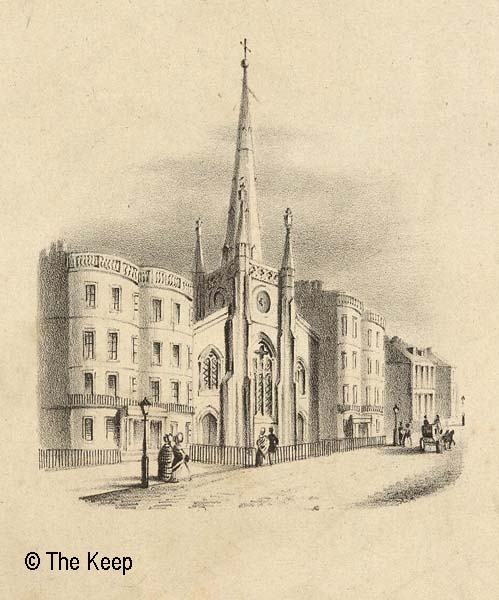
An engraving of Christ Church showing the spire on the tower, Montpelier Road, Brighton in 1838. Keep Ref: PDA-B-65
James Vaughan came to Brighton from Chelsea in 1836, as Curate at Brighton Parish Church (St. Nicholas), of which the Rev. H. M. Wagner was then Vicar. At this time Brighton was rapidly growing, and energetic efforts were being made to provide church accommodation sufficient for the needs of the people.
The east end of the town had St. James', St. Mary's, St. George's Chapel, and All Souls', erected in 1834: the central part was provided for by the Chapel Royal and Trinity Chapel in Ship Street. In the north, on the borders of the open country, was St. Peter's. The west end of the town, which was being developed as a fashionable quarter, apart from St. Margaret's Proprietary Chapel, was served by the Parish Church alone. It was in this direction, that Mr. Wagner now turned his attention.
He resolved to build a church there, which should be a chapel of ease to the Parish Church, and to place Mr. Vaughan in charge. Mr. George Cheeseman was the architect, and he and his son were the builders.
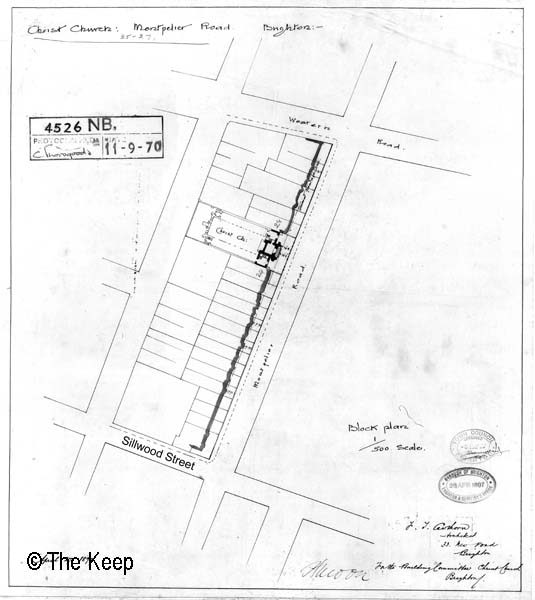
Christ Church was built on the west side of Montpelier Road between Western Road and Sillwood Street. Keep Ref: DB/D/134/4526.
The foundation stone was laid by the Vicar of Brighton on 13th June, 1837.
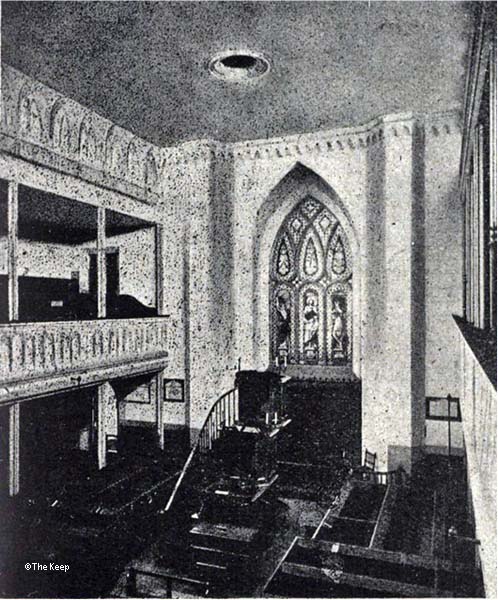
View towards the altar before restoration work was done on the church. Keep Ref: 1917 B&H Parochial Gazetteer.
The building was finished within a year, at a cost, including the site, of £4,600; the contributors to this included King William IV (who died a week after the foundation stone was laid) who gave £100, Queen Adelaide and Queen Victoria, who each gave £50.
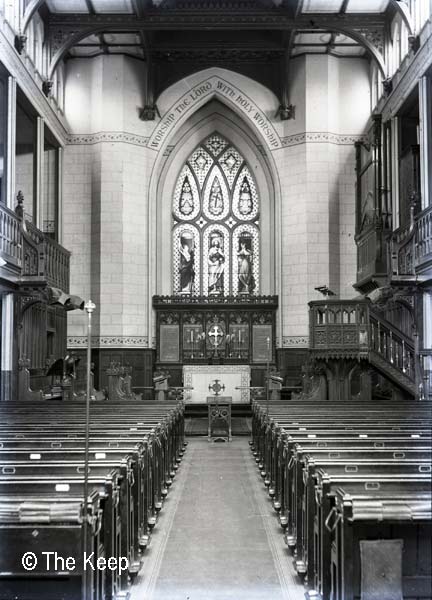
Interior view towards the altar post restoration c1925 picture from The Keep Archives. Ref: AMS 7312/14/66
It was the original intention to place the Altar at the west end of the church, where the entrance from Bedford Place was sited. To do this was due to three curious features of the church — the position of the Tower, which is at the extreme east of the building, behind the Altar, the entrances from Montpelier Road on both sides of the Choir and Sanctuary, and the most unusual position of the foundation stone at the South West corner of the building. This last was apparently due to the fact that, if the original plans had been carried out, it would have been in a position corresponding to the North East corner in a regularly orientated building. The alteration was due to the necessity of bringing the building into conformity with the regulations of the Church Building Commissioners.
The actual building was of brick, faced with cement: it was much enclosed by the surrounding houses, and was, in fact, hard to discover from the immediate neighbourhood. The most prominent feature of the exterior was the spire. The tower from which it sprang was 56 feet high; it was surrounded with buttresses, which were finished with pinnacles. The spire itself rose to a height of 130 feet from the ground, and was said to have been copied to some extent from that of Chichester Cathedral which is surmounted by a globe and cross, to symbolise the ultimate triumph of Christianity over the world.
The interior of the church as consecrated by the Lord Bishop of the Diocese (Dr. Otter) on Thursday, 26th April, 1838, was very plain. The ceiling was low and whitewashed; there were high pews, galleries on three sides, a three decker, and no organ. In fact, the church was without an organ until 1860, the singing up to that date being led by the wife of the clerk. The East window, which was not an outside window, was filled with painted glass, by Collins, of London, set in wooden tracery of no recognised order of Architecture. The three principal lights were occupied by figures of our Lord, and of Faith and Hope personified. The two latter figures were copied in colours from the sepia figures in the Joshua Reynolds window at New College, Oxford.
The accommodation provided is said, by a report published in 1838, to have been 1070, of which the large proportion of 620 may find accommodation in the seats appropriated as free sittings to the poor. Extensive vaults, capable of receiving 100 coffins, were constructed beneath the church, but only about twenty interments took place there before they were closed by an order in Council.
In 1875 a choir was first established, and in the same year the Incumbent was appointed Prebendary of Hova Villa in Chichester Cathedral. In 1886 advancing years and failing health led him to resign the living. Nearly 2000 people joined in signing an address of regret and gratitude to him on that occasion, and in presenting to him the sum of £1,550, as well as a £343 to found the “Vaughan" Scholarship at Brighton College. Three years later he died at Guildford in his 84th year, and was buried at Wraxall.
Mr. Vaughan was succeeded by the Rev. R. M. Hawkins, who had been Assistant Curate from 1872 to 1875. During this time the roof and ceiling needed urgent repairs to prevent water coming in. Once the repairs had been done the interior of the building was renovated: notably the ceiling was greatly improved, the west gallery removed and the organ placed at the east end of the south gallery, and the three decker pulpit was taken down. It was replaced by a teak pulpit of considerable height which was erected in memory of Mr. Vaughan.
Mr. Hawkins resigned in 1895, and was succeeded by the Rev. W. H. G. Mann, who, owing to ill health, did not come into residence for some time, and only lived a few months, dying suddenly at Boscombe in March, 1897. The Clergy Vestry was erected as a memorial to him. On his death the Rev. C; H. Hanning became Incumbent, and he was succeeded in 1902 by the late Prebendary Gerald Moor, whose task was, to a large extent, the establishment of the church finances on a sounder footing.
It was in the next Incumbency, that of the Rev. F. H. Brewin (1905-12), that a scheme was launched for improving the interior of the church. Damp and draughts were the main foes to be encountered: and it was determined so to redecorate and restore the interior that better conditions should prevail. The money was duly raised for the purpose, but the architect discovered that the exterior of the church, especially the roof and the somewhat unsubstantial clerestory, was in a dangerous state, and that it must be made safe before anything else could be attempted. This was done; though, unfortunately the spire had again to be repaired in 1916; but the other scheme was not forgotten, and after two years was put into execution. At the same time the West Porch, leading to Bedford Place, was added. One other matter of importance was undertaken by Mr. Brewin. He saw that pew rents must of necessity be an unstable source of income, and, therefore, inaugurated an Endowment Fund for which over £2,000 was raised, ensuring an income of about £80.
Since then, this has been largely increased by the legacy of the late Mr. E. A. Smith, who left an estate valued at over £9,000 to be divided between the Incumbents of Christ Church and St. Andrew's, Waterloo Street, for the benefit of their respective churches. This the late Vicar, the Rev. W. A. Carr decided to apply to the endowment. Mr. Brewin resigned in 1912 in order to undertake work in Canada, and was succeeded by Mr. Carr, whose Incumbency lasted less than three years, being closed by his unexpected and much regretted death on 23rd April, 1915. In his memory the screen and choir stalls, which were much too heavy for the church, were taken down, and choir stalls of oak substituted: the ones removed being given to St. Alban's, Coombe Road.
Christ Church still remained a Chapel of Ease to the Parish Church of Brighton. But it has a quasi-independent existence, for it was responsible for a district of about 4000 people, situated partly on the south of Western Road, west of Clarence Square, and partly north of that road, between Spring Street and Regent.
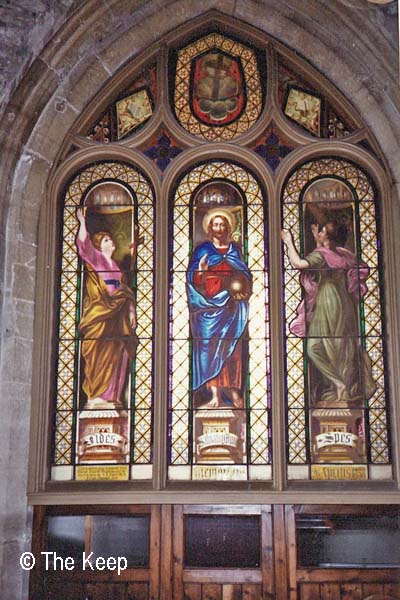
A photograph of the original east window from Christ
Church, removed in 1931 and taken to All Saints, Farmborough,
Somerset. Keep Ref: PAR 260/4/3/5.
Two things connected with the church remain to be mentioned. It has always been a centre of keen interest in the Overseas work of the church, and to that its vigour must be largely attributed, seeing that a church without the Missionary spirit is certain to be deficient in vitality. It still continues, as of old, to aid the C.M.S. and C.E.Z.M.S.: but it has added to the Societies which it supports, the S.P.G. and the Universities' Mission to Central Africa.
Nor would an account of Christ Church be complete without a mention of the schools. Erected in 1841, to provide on Church of England principles a thoroughly good education at a reasonable cost for the children of the middle classes, they have always been successful. Among the early masters was the late Mr. E. J. Marshall, of Grammar School fame. In 1892 the task of rebuilding and enlarging the Schools was undertaken, and on 9th November, 1894, they were re-opened. There were from time to time the usual financial difficulties aggravated by the cost incurred in rebuilding, but these were surmounted. In 1903 they became non-provided schools under the Local Education Authority, but they still have the right to charge fees of 6d. per week to the children attending them. Originally the Infant School in Crown Street was a department of these schools, but it has since been transferred to the L.E.A. Among many faithful supporters none can rank higher than the present Head Master of the Boys' School, Mr. J. Free-mantle, who was appointed an assistant as far back as 1874, and succeeded to the Headmastership in 1905.
Christ Church was not a building of great beauty or historical interest, yet it had its associations which all value, and it inspires in those who know it well a desire to say with the Psalmist: “Lord, I have loved the habitation of Thy House."
The last marriage took place on 15 April 1978.
Originally the church was a chapel of ease, with a parish created 1956. It was destroyed by fire in 1978 and formally declared redundant in 1981, leading to its demolition in 1982.
It has been replaced by a block of flats.
Photographs and plans of Christ Church
It was built in 1838 at a cost of £4600, with a contribution from H M Wagner, for James Vaughan, one of Wagner’s curates and a popular preacher. He remained there for 48 years until 1889, when it became a district chapel.

James Vaughan came to Brighton from Chelsea in 1836, as Curate at Brighton Parish Church (St. Nicholas), of which the Rev. H. M. Wagner was then Vicar. At this time Brighton was rapidly growing, and energetic efforts were being made to provide church accommodation sufficient for the needs of the people.
The east end of the town had St. James', St. Mary's, St. George's Chapel, and All Souls', erected in 1834: the central part was provided for by the Chapel Royal and Trinity Chapel in Ship Street. In the north, on the borders of the open country, was St. Peter's. The west end of the town, which was being developed as a fashionable quarter, apart from St. Margaret's Proprietary Chapel, was served by the Parish Church alone. It was in this direction, that Mr. Wagner now turned his attention.
He resolved to build a church there, which should be a chapel of ease to the Parish Church, and to place Mr. Vaughan in charge. Mr. George Cheeseman was the architect, and he and his son were the builders.

Christ Church was built on the west side of Montpelier Road between Western Road and Sillwood Street. Keep Ref: DB/D/134/4526.
The foundation stone was laid by the Vicar of Brighton on 13th June, 1837.

View towards the altar before restoration work was done on the church. Keep Ref: 1917 B&H Parochial Gazetteer.
The building was finished within a year, at a cost, including the site, of £4,600; the contributors to this included King William IV (who died a week after the foundation stone was laid) who gave £100, Queen Adelaide and Queen Victoria, who each gave £50.

It was the original intention to place the Altar at the west end of the church, where the entrance from Bedford Place was sited. To do this was due to three curious features of the church — the position of the Tower, which is at the extreme east of the building, behind the Altar, the entrances from Montpelier Road on both sides of the Choir and Sanctuary, and the most unusual position of the foundation stone at the South West corner of the building. This last was apparently due to the fact that, if the original plans had been carried out, it would have been in a position corresponding to the North East corner in a regularly orientated building. The alteration was due to the necessity of bringing the building into conformity with the regulations of the Church Building Commissioners.
The actual building was of brick, faced with cement: it was much enclosed by the surrounding houses, and was, in fact, hard to discover from the immediate neighbourhood. The most prominent feature of the exterior was the spire. The tower from which it sprang was 56 feet high; it was surrounded with buttresses, which were finished with pinnacles. The spire itself rose to a height of 130 feet from the ground, and was said to have been copied to some extent from that of Chichester Cathedral which is surmounted by a globe and cross, to symbolise the ultimate triumph of Christianity over the world.
The interior of the church as consecrated by the Lord Bishop of the Diocese (Dr. Otter) on Thursday, 26th April, 1838, was very plain. The ceiling was low and whitewashed; there were high pews, galleries on three sides, a three decker, and no organ. In fact, the church was without an organ until 1860, the singing up to that date being led by the wife of the clerk. The East window, which was not an outside window, was filled with painted glass, by Collins, of London, set in wooden tracery of no recognised order of Architecture. The three principal lights were occupied by figures of our Lord, and of Faith and Hope personified. The two latter figures were copied in colours from the sepia figures in the Joshua Reynolds window at New College, Oxford.
The accommodation provided is said, by a report published in 1838, to have been 1070, of which the large proportion of 620 may find accommodation in the seats appropriated as free sittings to the poor. Extensive vaults, capable of receiving 100 coffins, were constructed beneath the church, but only about twenty interments took place there before they were closed by an order in Council.
In 1875 a choir was first established, and in the same year the Incumbent was appointed Prebendary of Hova Villa in Chichester Cathedral. In 1886 advancing years and failing health led him to resign the living. Nearly 2000 people joined in signing an address of regret and gratitude to him on that occasion, and in presenting to him the sum of £1,550, as well as a £343 to found the “Vaughan" Scholarship at Brighton College. Three years later he died at Guildford in his 84th year, and was buried at Wraxall.
Mr. Vaughan was succeeded by the Rev. R. M. Hawkins, who had been Assistant Curate from 1872 to 1875. During this time the roof and ceiling needed urgent repairs to prevent water coming in. Once the repairs had been done the interior of the building was renovated: notably the ceiling was greatly improved, the west gallery removed and the organ placed at the east end of the south gallery, and the three decker pulpit was taken down. It was replaced by a teak pulpit of considerable height which was erected in memory of Mr. Vaughan.
Mr. Hawkins resigned in 1895, and was succeeded by the Rev. W. H. G. Mann, who, owing to ill health, did not come into residence for some time, and only lived a few months, dying suddenly at Boscombe in March, 1897. The Clergy Vestry was erected as a memorial to him. On his death the Rev. C; H. Hanning became Incumbent, and he was succeeded in 1902 by the late Prebendary Gerald Moor, whose task was, to a large extent, the establishment of the church finances on a sounder footing.
It was in the next Incumbency, that of the Rev. F. H. Brewin (1905-12), that a scheme was launched for improving the interior of the church. Damp and draughts were the main foes to be encountered: and it was determined so to redecorate and restore the interior that better conditions should prevail. The money was duly raised for the purpose, but the architect discovered that the exterior of the church, especially the roof and the somewhat unsubstantial clerestory, was in a dangerous state, and that it must be made safe before anything else could be attempted. This was done; though, unfortunately the spire had again to be repaired in 1916; but the other scheme was not forgotten, and after two years was put into execution. At the same time the West Porch, leading to Bedford Place, was added. One other matter of importance was undertaken by Mr. Brewin. He saw that pew rents must of necessity be an unstable source of income, and, therefore, inaugurated an Endowment Fund for which over £2,000 was raised, ensuring an income of about £80.
Since then, this has been largely increased by the legacy of the late Mr. E. A. Smith, who left an estate valued at over £9,000 to be divided between the Incumbents of Christ Church and St. Andrew's, Waterloo Street, for the benefit of their respective churches. This the late Vicar, the Rev. W. A. Carr decided to apply to the endowment. Mr. Brewin resigned in 1912 in order to undertake work in Canada, and was succeeded by Mr. Carr, whose Incumbency lasted less than three years, being closed by his unexpected and much regretted death on 23rd April, 1915. In his memory the screen and choir stalls, which were much too heavy for the church, were taken down, and choir stalls of oak substituted: the ones removed being given to St. Alban's, Coombe Road.
Christ Church still remained a Chapel of Ease to the Parish Church of Brighton. But it has a quasi-independent existence, for it was responsible for a district of about 4000 people, situated partly on the south of Western Road, west of Clarence Square, and partly north of that road, between Spring Street and Regent.

Two things connected with the church remain to be mentioned. It has always been a centre of keen interest in the Overseas work of the church, and to that its vigour must be largely attributed, seeing that a church without the Missionary spirit is certain to be deficient in vitality. It still continues, as of old, to aid the C.M.S. and C.E.Z.M.S.: but it has added to the Societies which it supports, the S.P.G. and the Universities' Mission to Central Africa.
Nor would an account of Christ Church be complete without a mention of the schools. Erected in 1841, to provide on Church of England principles a thoroughly good education at a reasonable cost for the children of the middle classes, they have always been successful. Among the early masters was the late Mr. E. J. Marshall, of Grammar School fame. In 1892 the task of rebuilding and enlarging the Schools was undertaken, and on 9th November, 1894, they were re-opened. There were from time to time the usual financial difficulties aggravated by the cost incurred in rebuilding, but these were surmounted. In 1903 they became non-provided schools under the Local Education Authority, but they still have the right to charge fees of 6d. per week to the children attending them. Originally the Infant School in Crown Street was a department of these schools, but it has since been transferred to the L.E.A. Among many faithful supporters none can rank higher than the present Head Master of the Boys' School, Mr. J. Free-mantle, who was appointed an assistant as far back as 1874, and succeeded to the Headmastership in 1905.
Christ Church was not a building of great beauty or historical interest, yet it had its associations which all value, and it inspires in those who know it well a desire to say with the Psalmist: “Lord, I have loved the habitation of Thy House."
The last marriage took place on 15 April 1978.
Originally the church was a chapel of ease, with a parish created 1956. It was destroyed by fire in 1978 and formally declared redundant in 1981, leading to its demolition in 1982.
It has been replaced by a block of flats.
Photographs and plans of Christ Church
